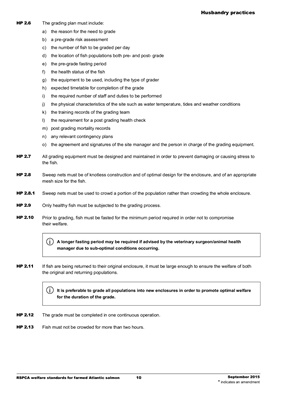
Husbandry practices
RSPCA welfare standards for farmed Atlantic salmon 10 September 2015
* indicates an amendment
HP 2.6 The grading plan must include:
a) the reason for the need to grade
b) a pre-grade risk assessment
c) the number of fish to be graded per day
d) the location of fish populations both pre- and post- grade
e) the pre-grade fasting period
f) the health status of the fish
g) the equipment to be used, including the type of grader
h) expected timetable for completion of the grade
i) the required number of staff and duties to be performed
j) the physical characteristics of the site such as water temperature, tides and weather conditions
k) the training records of the grading team
l) the requirement for a post grading health check
m) post grading mortality records
n) any relevant contingency plans
o) the agreement and signatures of the site manager and the person in charge of the grading equipment.
HP 2.7 All grading equipment must be designed and maintained in order to prevent damaging or causing stress to
the fish.
HP 2.8 Sweep nets must be of knotless construction and of optimal design for the enclosure, and of an appropriate
mesh size for the fish.
HP 2.8.1 Sweep nets must be used to crowd a portion of the population rather than crowding the whole enclosure.
HP 2.9 Only healthy fish must be subjected to the grading process.
HP 2.10 Prior to grading, fish must be fasted for the minimum period required in order not to compromise
their welfare.
A longer fasting period may be required if advised by the veterinary surgeon/animal health
manager due to sub-optimal conditions occurring.
HP 2.11 If fish are being returned to their original enclosure, it must be large enough to ensure the welfare of both
the original and returning populations.
It is preferable to grade all populations into new enclosures in order to promote optimal welfare
for the duration of the grade.
HP 2.12 The grade must be completed in one continuous operation.
HP 2.13 Fish must not be crowded for more than two hours.
i
i